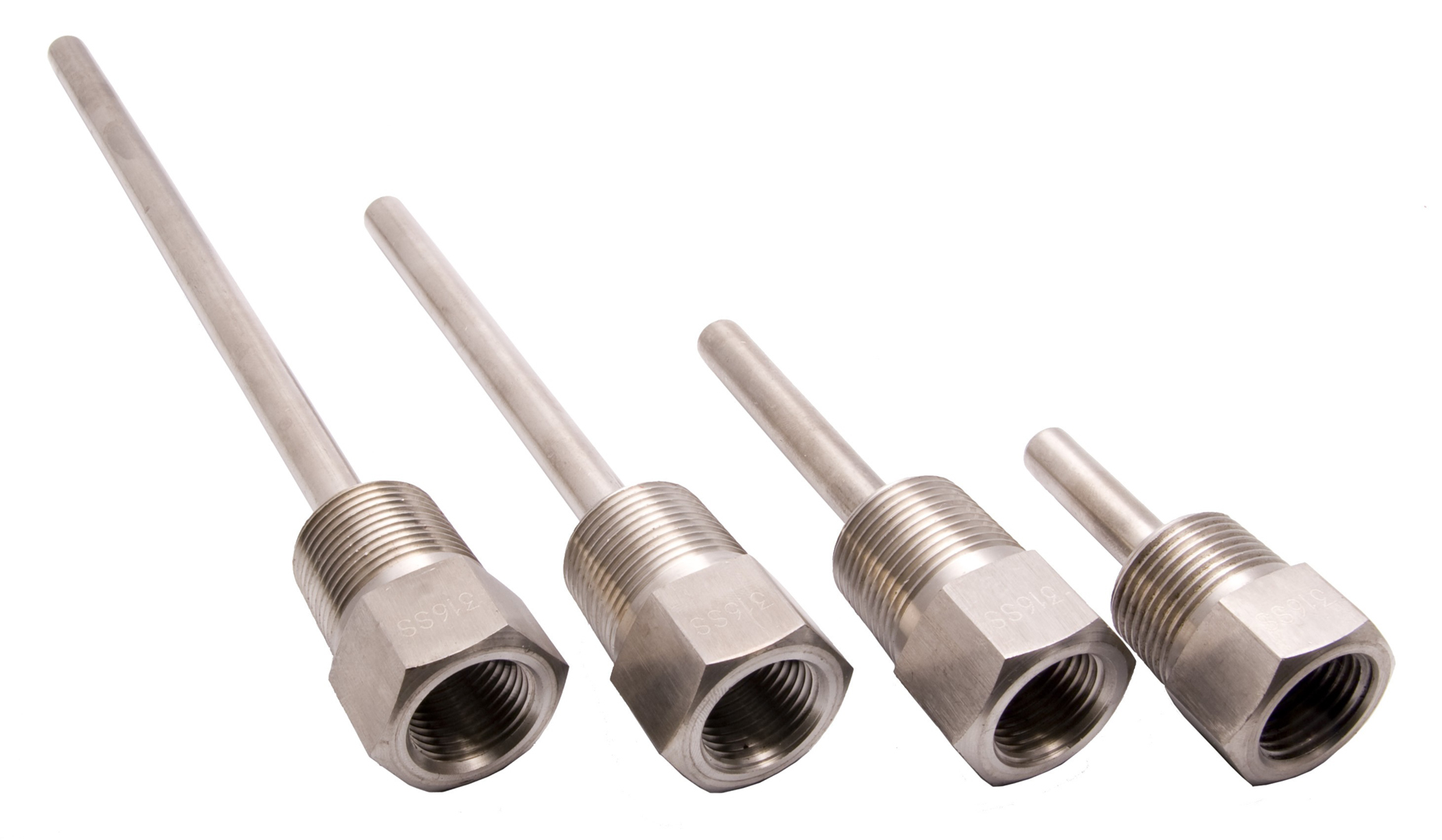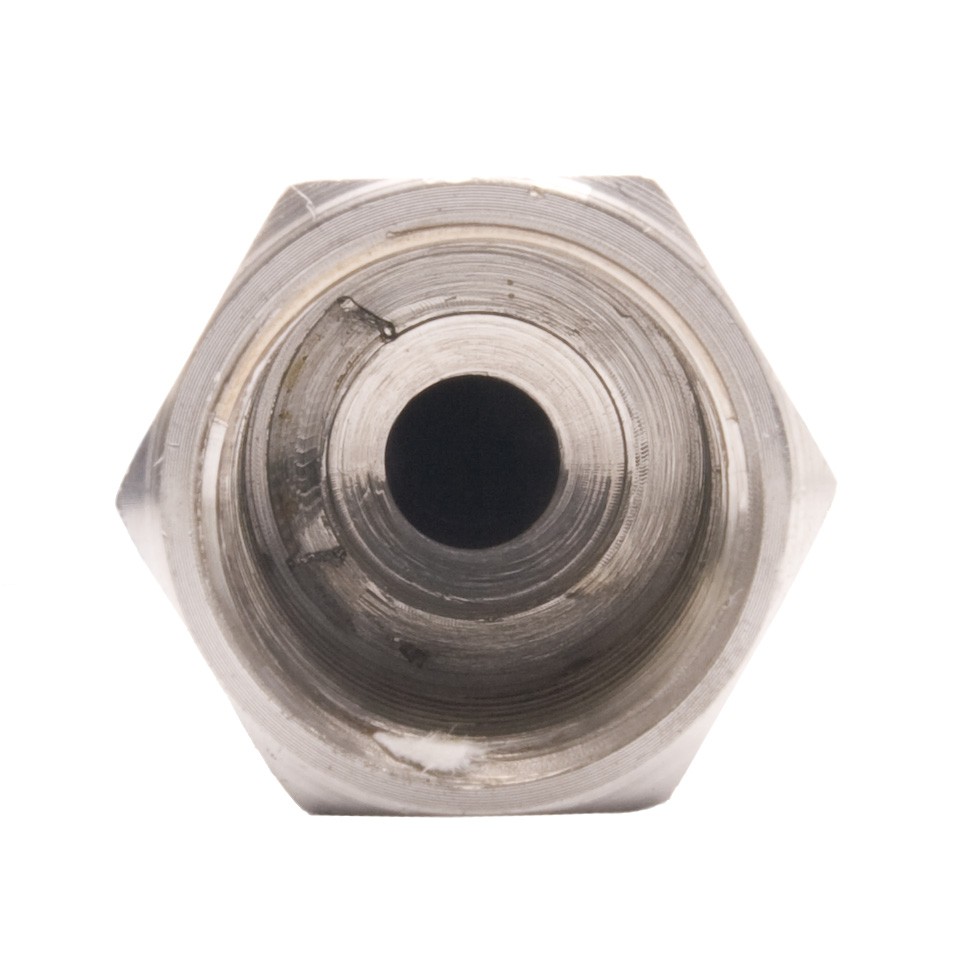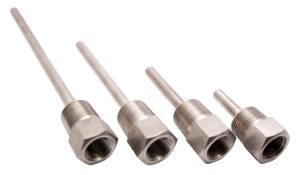Description
The Thermowells are a vital component of many industrial processes and systems where temperature measurement is required. Also, it is designed to protect temperature sensors, such as thermocouples or resistance temperature detectors (RTDs), from harsh processing environments while ensuring accurate and reliable temperature readings.
Used extensively in industries like oil and gas, petrochemical, pharmaceutical, power generation, and food processing, they provide a protective barrier between the temperature sensor and the process fluid or gas. In Addition, this separation is crucial in preventing sensor damage and ensuring accurate temperature measurements.
Thermowells are typically cylindrical in shape, with a closed end and an open end that allows for sensor installation. Also, they are constructed from various materials such as stainless steel, carbon steel, brass, or exotic alloys depending on the process conditions, such as pressure, temperature, and the chemical composition of the medium being measured.
Functions
One of the main functions of a thermowell is to isolate the temperature sensor from the process medium. Furthermore, this isolation helps protect the sensor from corrosion, erosion, high pressures, and reactive substances that may exist in the process fluid or gas. Without a thermowell, the sensor would be directly exposed to these elements, leading to inaccurate readings, sensor failure, and potential safety hazards.
The design of the isolator is critical for its performance and durability. Factors such as the thermowell length, outer diameter, wall thickness, and materials used all impact its ability to withstand the harsh conditions it may encounter. Additionally, the length of them is crucial as it determines how far the sensor is inserted into the process stream. Finally, this insertion length needs to be carefully calculated to ensure accurate temperature readings while minimizing any potential lag or delay.
Another important consideration in thermowell design is vibration resistance. Industrial processes often generate vibrations that can affect the accuracy of temperature measurements. Also, to mitigate this, thermowell can be designed with specific features like flanges, collars, or support rods to dampen vibrations and maintain sensor stability.
Styles
Thermowells are available in different styles, each designed for specific applications. The most common types include threaded, flanged, and welded thermowells. Moreover, threaded thermowells are typically used for low-pressure applications, while flanged thermowells are suitable for high-pressure systems. Welded thermowells provide a permanent and hermetic seal for critical or hazardous processes.
Installation
Installation of thermowells requires careful consideration of factors such as process conditions, pressure, temperature, and medium characteristics. In addition, it is essential to follow industry standards and guidelines to ensure proper installation, which includes selecting the right thermowell length, diameter, and material for the specific application.
Maintenance
Regular maintenance and inspection of thermowells are crucial for their continued functionality and accuracy. Monitoring for signs of corrosion, erosion, or damage is important to prevent any compromises in temperature measurements. If a thermowell shows signs of wear or damage, it should be immediately replaced or repaired to avoid jeopardizing process efficiency and safety.
In conclusion, thermowells play a vital role in temperature measurement within industrial processes. They protect temperature sensors from harsh conditions, ensuring accurate and reliable temperature readings. Proper design, materials selection, and installation are essential to maximize thermowell performance and longevity in various applications across multiple industries.
Various Types
There are several types of thermowells available to suit different applications and process conditions. The main types will include:
Threaded Thermowells
Threaded thermowells have external threads that allow them to be directly screwed into a threaded opening in a process vessel or pipeline. They are commonly used in low-pressure applications and are available in various materials and lengths to accommodate different temperature-sensing requirements.
Flanged Thermowells
Flanged thermowells have a flange at one end, which allows for easy installation and removal from a process vessel or pipeline using bolts. They are often used in high-pressure applications and provide a secure and leak-tight connection.
Weld-in Thermowells
Weld-in thermowells have a cylindrical body that is welded directly into a process vessel or pipeline. They provide a permanent and hermetic seal, making them suitable for critical or hazardous processes.
Van Stone Thermowells
Van Stone thermowells consist of a flange and a separate thermowell pipe. The thermowell pipe is inserted through the flange and secured with a compression fitting. This type allows for easy removal of the sensing element without disturbing the process connection.
Sanitary Thermowells
Sanitary thermowells are designed for hygienic applications in industries such as food and beverage, pharmaceuticals, and biotechnology. They feature smooth surfaces, crevice-free designs, and sanitary fittings to meet strict hygiene standards.
Socket-Weld Thermowells
Socket-weld thermowells have a cylindrical body that is welded into a socket-weld opening in a process vessel or pipeline. They offer a tight and reliable connection, particularly in high-temperature and high-pressure applications.
These are some of the common types used in industrial applications. It is important to select the appropriate thermowell type based on factors such as process conditions, pressure, temperature, and compatibility with the medium being measured to ensure accurate temperature readings and long-term reliability.
Advantages of Thermowells
Protection
The primary advantage of thermowells is that they provide protection to temperature sensors, such as thermocouples or RTDs, from harsh process conditions. They act as a barrier, shielding the sensor from corrosion, erosion, high pressures, and reactive substances present in the process fluid or gas. This protection increases the lifespan of the temperature sensor and ensures accurate temperature measurements.
Versatility
Thermowells are available in various materials, lengths, and styles to accommodate a wide range of process conditions and applications. Whether it’s low-pressure or high-pressure systems, different temperature ranges, or specific industry requirements, they are designed to meet those needs. This versatility allows for flexibility in installation and compatibility with different industrial processes.
Accuracy
Thermowells play a crucial role in maintaining accurate temperature measurements. By isolating the temperature sensor from the process medium, the wells reduce the effects of thermal lag, hysteresis, or fluctuations caused by the process conditions. Finally, this ensures that temperature readings are more reliable and precise.
Safety
In many industrial processes, accurate temperature measurements are vital for ensuring safety. Thermowells help prevent sensor failures or inaccuracies, which could potentially lead to process malfunctions, equipment damage, or even endanger personnel. By providing a protective enclosure for temperature sensors, thermowells contribute to safer operations.
Disadvantages of Thermowells
Response Time
While thermowells protect temperature sensors, they can introduce a delay or lag in response time. The thermal conductivity of the material slows down the transfer of heat to the temperature sensor, leading to a slightly longer response time compared to direct immersion of the sensor into the process medium. However, this delay is usually minimal and can be accounted for in temperature readings.
Installation Complexity
Installing one requires careful consideration of process conditions, proper sizing, and adherence to installation guidelines. Improper installation can lead to inaccurate readings, leaks, or damage to the well or the process vessel. Furthermore, it is important to ensure that wells are correctly installed to achieve accurate and reliable temperature measurements.
Cost
They add an extra cost to temperature measurement systems. The materials, fabrication, and installation of thermowells incur additional expenses compared to direct sensor immersion. However, considering the protection, longevity, and accuracy they provide, thermowells are often deemed a worthwhile investment in industrial processes where harsh conditions are present.
It is important to carefully evaluate the advantages and disadvantages of thermowells based on specific application requirements and process conditions to determine their suitability.
Applications
Thermowells find applications in a wide range of industries where temperature measurements are crucial for process control, monitoring, and safety. Finally, here are some of the industries in which thermowell are commonly used:
Oil and Gas
Thermowells are extensively utilized in the oil and gas industry, where they are exposed to aggressive and high-temperature environments. Moreover, they help monitor temperatures in pipelines, refineries, drilling operations, and storage tanks.
Petrochemical
In petrochemical plants, thermowells are used to measure temperature in various processes such as chemical reactors, distillation columns, and heat exchangers. In addition, they provide accurate temperature readings and protect sensors from corrosive chemicals and high pressures.
Power Generation
Thermowells play a crucial role in power plants, both conventional and renewable. They are used to measure temperatures in steam turbines, boilers, condensers, and heat recovery systems, ensuring efficient and safe operation.
Food Processing
The food processing industry utilizes thermowells in applications such as cooking, pasteurization, sterilization, and cooling processes. Sanitary thermowells are specifically designed to meet hygienic standards and are commonly used in the dairy, beverage, and meat processing sectors.
Pharmaceutical
In pharmaceutical manufacturing, thermowells are vital for controlling and monitoring temperature-sensitive processes like fermentation, sterilization, and drying. Additionally, they help maintain quality, yield, and compliance with regulatory standards.
Chemical
Thermowells are extensively employed in the chemical industry for temperature measurement and control in reaction vessels, distillation columns, heat exchangers, and storage tanks. Also, they withstand the corrosive nature of chemicals and ensure accurate temperature readings.
Automotive
In automotive manufacturing, thermowells are utilized in various processes such as heat treating, welding, and paint curing. Moreover, they help ensure precise temperature control and quality assurance in automotive components and assemblies.
HVAC (Heating, Ventilation, and Air Conditioning)
Thermowells are used in the HVAC industry for temperature monitoring in HVAC systems, including boilers, chillers, air conditioning units, and control systems. Additionally, they enable efficient and optimized operation of HVAC equipment.
These are just a few examples of industries that rely on thermowells for temperature measurement. Thermowells find applications across numerous other sectors where accurate and reliable temperature sensing is essential for process control, productivity, and safety.
Thermowells Specifications:
| Process Connections: | 1/2″ Male NPT / NST Threaded | |
| Instrument Connection: | 1/2″ Female NPT / NST Standard | |
| Shank Configurations: | Straight | |
| Stem Length: | 2-1/2″ to 9″ available | |
| Normal Ambient Temp.: | -25F to +520F | |
| Pressure rating | 800psi | |
| Internal Bore Diameter | 1/4″ or 63mm | |
If this does not meet your application requirements, pls Contact Us or see the other related products



